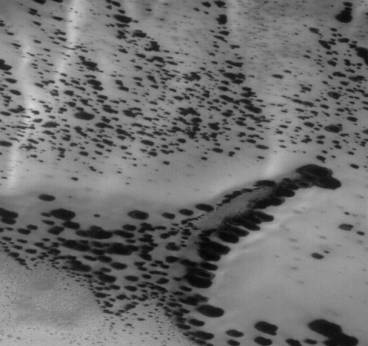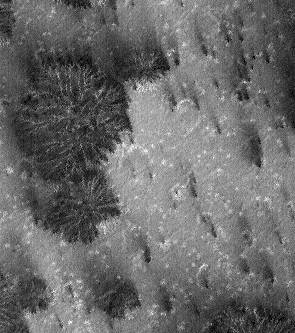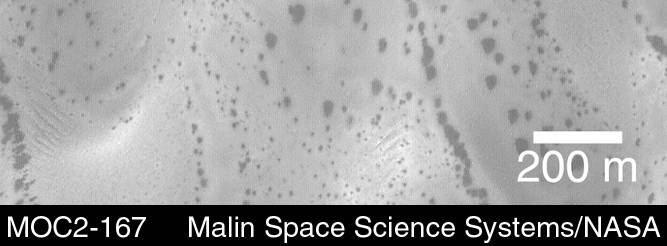Update March 2002: some news here.
Arthur C. Clarke's provocative statements at the beginning of 2001 (no irony meant) about vegetation on Mars have urged speculative efforts. One aspect of this effort is devoted to the alleged "tubes", which are probably series of natural dunes. The other aspect relates to the dark spot seen mostly on the south pole dunes, appearing in seasonal patterns.

|
In the MSC-published image below, the dark spots, Clarke's alleged "bushes", are in relative isolation. A shadowing seems to indicate that the formation are elevated.
As on terrestrial forests, these leafy-looking formations proceed to "clump" together until the field covered by the MGS camera reveals a landscape of dense "foilage."
The alternate, non-vegetable explanation from Malin Space Science Center, cannot be ruled out at this time. The shadow indicating an elevation can just as well be a wind deposit of the darker matter.

|
Clarke's proposed "bushes" are candidates for relatively simple extant organisms thriving on the Martian surface. They show seasonal growing. Their alignment with dune tops is consistent with the growing of bushes in area of Erath deserts. But they can just as well be inorganic formation just as the MSC explained.
The "defrosting" theory is not necessarily the correct one either.
It is just a pity that Mars Polar Lander, the probe that would have put this debate to a rest, hopelessly silenced. Although it was later found intact by a military imagery agency, maddeningly intact on its landing gear. But silent.
"They look like bushes!" That's what almost everyone says when they see the dark features found in pictures taken of sand dunes in the polar regions as they are beginning to defrost after a long, cold winter. It is hard to escape the fact that, at first glance, these images acquired by the Mars Global Surveyor (MGS) Mars Orbiter Camera (MOC) over both polar regions during the spring and summer seasons, do indeed resemble aerial photographs of sand dune fields on Earth - complete with vegetation growing on and around them! Of course, this is not what the features are, as we describe below and in related picture captions. Still, don't they look like vegetation to you? Shown here are two views of the same MGS MOC image. On the left is the full scene, on the right is an expanded view of a portion of the scene on the left. The bright, smooth surfaces that are dotted with occasional, nearly triangular dark spots are sand dunes covered by winter frost.
The MGS MOC has been used over the past several months (April-August 1999) to monitor dark spots as they form and evolve on polar dune surfaces. The dark spots typically appear first along the lower margins of a dune - similar to the position of bushes and tufts of grass that occur in and among some sand dunes on Earth.
Because the martian air pressure is very low - 100 times lower than at Sea Level on Earth - ice on Mars does not melt and become liquid when it warms up. Instead, ice sublimes - that is, it changes directly from solid to gas, just as "dry ice" does on Earth. As polar dunes emerge from the months-long winter night, and first become exposed to sunlight, the bright winter frost and snow begins to sublime. This process is not uniform everywhere on a dune, but begins in small spots and then over several months it spreads until the entire dune is spotted like a leopard.
The early stages of the defrosting process - as in the picture shown here - give the impression that something is "growing" on the dunes. The sand underneath the frost is dark, just like basalt beach sand in Hawaii. Once it is exposed to sunlight, the dark sand probably absorbs sunlight and helps speed the defrosting of each sand dune.
This picture was taken by MGS MOC on July 21, 1999. The dunes are located in the south polar region and are expected to be completely defrosted by November or December 1999. North is approximately up, and sunlight illuminates the scene from the upper left. The 500 meter scale bar equals 547 yards; the 300 meter scale is also 328 yards.
This is a simple and reasonable possible explanation. NASA also says:
The patterns created by dark spots on defrosting south polar dunes are often strange and beautiful. This picture, which the Mars Orbiter Camera team has dubbed, "the snow leopard," shows a dune field located at 61.5°S, 18.9°W, as it appeared on July 1, 1999. The spots are areas where dark sand has been exposed from beneath bright frost as the south polar winter cap begins to retreat. Many of the spots have a diffuse, bright ring around them - this is thought to be fresh frost that was re-precipitated after being removed from the dark spot. The spots seen on defrosting polar dunes are a new phenomenon that was not observed by previous spacecraft missions to Mars. Thus, there is much about these features that remains unknown. For example, no one yet knows why the dunes become defrosted by forming small spots that grow and grow over time. No one knows for sure if the bright rings around the dark spots are actually composed of re-precipitated frost. And no one knows for sure why some dunes show spots that appear to be "lined-up."
And:
The image shown here changed the earlier impression. The dark spots and streaks do not result from explosions. The spots - though not well understood - represent the earliest stages of defrosting on the sand dunes. The streaks, instead of being caused by small explosions, are instead the result of wind. In this picture, the fine, dark streaks show essentially identical orientations from spot to spot (e.g., compare the spots seen in boxes (a) and (b)). Each ray of dark material must result from wind blowing from a particular direction - for example, all of the spots in this picture exhibit a ray that points toward the upper left corner of the image, and each of these rays indicates the same wind regime. Each spot also has a ray pointing toward the lower right and top/upper-right. These, too, must indicate periods when the wind was strong enough to move materials, consistently, in only one direction.
The explanation is fairly reasonable and accounts for the spot in a more conventional manner than the vegetation theory. However, it does imply that the wind is still currently strong enough on the planet to perform this effect, it might imply that there is a much denser atmosphere on Mars than usually estimated.
Also, the defrosting hypothesis is an alternate, more conventional explanation, but it does not rule out the vegetation explanation.
As mentioned previously on this site, there are other, perhaps equally provocative candidate life forms visible in photos taken by the Mars Global Surveyor spacecraft. For example, the dark spots below may represent hardy fungal colonies.

|
Mounting evidence indicates that Mars is a more hospitable planet than previously accepted by the planetary science community. As our perception of the so called "Red Planet" evolves, it is hoped that these first tantalizing glimpses of possible life may help sway our bias toward an image of an unexpectedly green planet.
But so far, the "bushes" and "glass pipes" mentioned by Arthur C. Clarke and other researchers have possible explanations that do not involve vegetation.
However it should be remembered that, very oddly, the Mars Global Surveyor camera, pretty much unlike any other color camera ever constructed, does not show the green color, but only the red and the blue. The reason for this quite unusual and seemingly absurd technological choice is left to our imagination...
Almost needless to say, the bulletproof detection of macroscopic as well as microscopic lifeforms on Mars would necessitate a crewed mission. Perhaps NASA's disturbing silence regarding many disturbing features indicates the current political bias against manned spaceflight.
In compliance with the MSSS image use:
"All Mars Orbiter Camera images are used courtesy of Malin Space Science Science Systems. Pursuant to the Image Use Policy , all original imaging credit is given to NASA/JPL/Malin Space Science Systems."